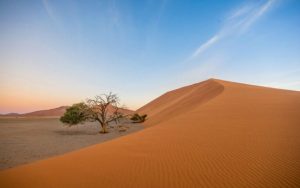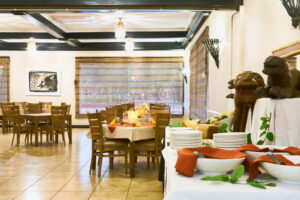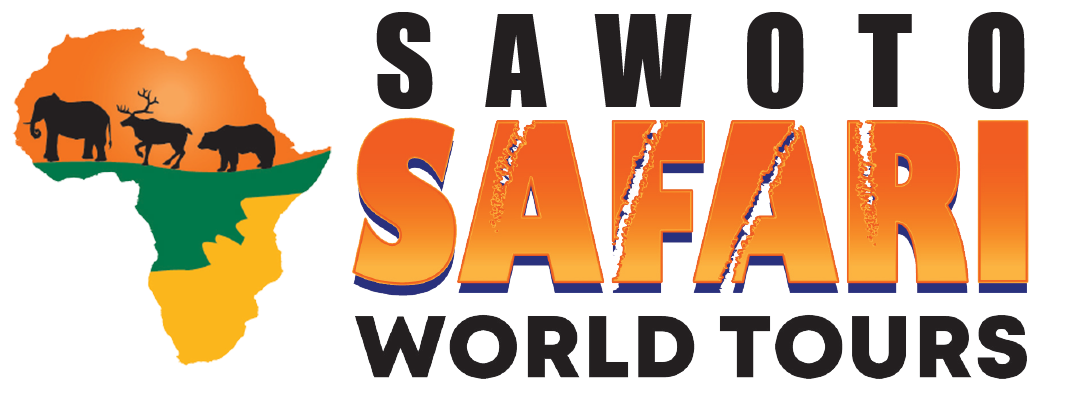Do not hesitate to give us a call. We team is here to talk to you.
+264 81 8211 521
info@safariworldtours.com
Tour Details:
10-Day Wilderness Namibia Safari is designed to visit the main highlights that Namibia has to offer in Africa. In just 9 days we would never be able to fit in everything you wanted to see but you will see the main attractions.
You will spend time amongst the ancient dunes in Sossusvlei, and go back in time to the coastal time of Swakopmund. Experience the vast landscapes of Otjiwarongo and exceptional game viewing at the world-famous Etosha National Park.
• Upon Booking a 10% non-refundable Deposit is required to Confirm booking of Tour/Activity/
Accommodation or Car Rental.
• Remaining 90% should be paid not later than 30 Days Prior to Departure.
• If tour is within 40 days or less prior to booking full payment is required.
• Your deposit can either be made through a Bank Transfer, Online Debit or Credit Card Payment.

Guest will be picked up at the airport and depart to Windhoek and will be picked up by the tour guide after lunch to go on a Windhoek Township tour if they arrive early In Windhoek and if times permits otherwise they will do the city tour the next morning before departing to the Dunes.
Windhoek is situated in Central Namibia; the cosmopolitan city of Windhoek serves as the capital of the country.
It is home to an international airport and a plethora of restaurants, shops, entertainment venues, and accommodation options. The city is clean, safe, and well-organized, with a colonial legacy that is reflected in its many German eateries and shops, and the widespread use of the German language.
Included Activities: Township Tour
Meals: Dinner

Guest will have breakfast and depart to the Sossusvlei area. Along the way, clients will stop at Rehoboth where the guide will buy snacks for 45 minutes and this is an opportunity for guests to get some snacks and drinks for the road.
Guest can lunch at 12h00-13h00 along the road by a rest place. After arrival, guests will have leisure time before going on a Sundowner drive to Elim Dune around 17h30 or 18h00.
Included Activity: Sundowner at Elim Dune

Guest will wake up and have breakfast before going into the park for Sossusvlei Excursion which includes Dune 45, Deadvlei, Hiddenvlei, and Big Daddy.
The tour guide will have regular stops to let clients take pictures and have some exposure to the Dunes. Guest will be back around lunchtime and will have some leisure time for themselves at the pool.
Meals: Breakfast & Dinner
Included Activity: Sossuvlei Excursion ( Deadvlei, Dune 45, Big Daddy, Sesriem Canyon,
Hiddenvlei, )
Overnight: Sesriem Campsite

Guest departs to Swakopmund early morning at around 09:00 am from Sossusvlei. It’s about 5 hours’ drive to Swakopmund.
Once clients have arrived in Walvis Bay they will buy lunch and depart to Swakopmund, When Clients arrive in Swakopmund they will check in and be taken by the guide for their activity (Quad biking and Sandboard) which is about a 2-hour activity. After the activity clients will go freshen up for dinner at a Restaurant.
Meals: Breakfast
Included Activity: Quad Biking and Sandboard
Optional Activity: Boat cruise, living desert

Today you head into one of the most beautiful desert regions in Namibia, Brandberg. This vast desert landscape is known as one of the most beautiful regions in Namibia. Huge, untamed, and ruggedly beautiful, Damaraland is an exceptionally scenic landscape featuring open plains, ancient valleys, and spectacular rock formations.
The major attractions are the sacred Spitzkoppe, the Brandberg, Twyfelfontein, Vingerklip, and the otherworldly Petrified Forest.
Visitors can take in the dramatic vistas, catch a glimpse of the rare desert-adapted elephant, and enjoy spectacular stargazing in crystal-clear night skies from one of the many safari camps dotting Damaraland. Other popular activities include guided drives, nature walks, and visiting the local communities. Don’t miss the opportunity to view Damaraland’s world-famous ancient rock art.
Meals: Breakfast and Dinner
Included Activities: Game Drive
Overnight: Brandberg Rest Campsite

Guest will have breakfast and take off to Damaraland which is a nature reserve idyllically located along a palm-lined tributary of the Uniab River, halfway between Swakopmund and Etosha, providing an ideal base from which to see the sights of the Kunene region or embark on one of the many local hiking trails.
Water is scarce in this area, so the river’s presence often lures elephants closer to the camps.
Meals: Breakfast & Dinner
Included Activity: Game Drive
Oppi-Koppi Restcamp, Damaraland

Clients are pick up in the Morning at 09:00 am and depart to Etosha and on arrival clients will get lunch and after Lunch, if time permits, enter Etosha for an afternoon game drive.
Depending on how often you stop today, on entering the park, the first stop would be Okaukuejo where you pay your entry fee and I suggest you pop in at the local shop to purchase some drinks and snacks and most importantly, a map of Etosha which will show you all the waterholes along the way.
Etosha has lions, giraffes, rhinos, zebras, springbok and elephants. This on top of many lesser and common plains herds, and abundant birds makes game viewing in Etosha.
Meals included: Breakfast and Dinner
Included Activities: Afternoon Game Drive

Clients will have early breakfast and then go on the Full day game drive around 12h00 -13h00 clients will have lunch inside the park and continue with the game drive up till the afternoon after the game drive guests will have leisure time to enjoy the atmosphere before dinner.
Included Activity: Full-day Game Drive

Clients will grab early breakfast and depart to Waterberg in north-central Namibia named for the springs that emanate from its foothills, the Waterberg Plateau National Park is a fascinating geological site featuring compressed sandstone crags, 200 million-year-old dinosaur footprints, and petrified sand dunes.
The area’s natural water sources make it far more fertile than its environs, and the park is blessed with a plethora of plant and animal species, including leopards, rhinoceros, vultures, cheetahs, bush babies, ferns, and fig trees.
Meals: Breakfast, and Dinner
Included Activities: Tracking Rhinos
Overnight: Waterberg Camp NWR
Clients will refresh in the morning and depart after breakfast to the Airport.
Etosha National Park spans an area of 22,270 square kilometres (8,600 square miles). The Etosha pan, which covers an area of 4,769 square kilometres (1,840 square miles) is 23% of the total area of Etosha National Park
The massive Etosha National Park is located in northwestern Namibia, in the country’s Kunene region.
Travelers planning on visiting Etosha in the winter months have one less thing to worry about: the park is entirely malaria-free during the dry season, when mosquitos are unable to breed. However, in the wetter months from November to June, travelers are encouraged to take anti-malaria medication. The risk of contracting malaria in Etosha, though, is incredibly slim.
The largest salt pan in Africa, the Etosha Pan is a dry lakebed that can be seen from space. Believed to have been formed 100 million years ago, some of the park’s wildlife use the pan as a salt lick in the dry season, and migrating flamingos flock to the area during particularly rainy wet seasons.
It shows some of the most common and rarest wildlife species.
Yes
May to August
Sun protective clothing with an effective sunscreen and a wide-brimmed hat. The sun on the white sand also makes sunglasses useful to combat the glare while looking for wildlife and birds. Binoculars Are An Etosha Game-Viewing Essential: The best game-viewing happens with the help of high-quality binoculars.
Sleeping on top a car gives you an added sense of security in the wilderness. Generally speaking, camping is safe, even on the non-fenced campsites. Most animals do not perceive tents as tents with people inside, but interpret them as large animals or objects, hence an attack is very unlikely.
The breath-taking mountainous region of Damaraland is home to an assortment of desert-adapted wildlife such as elephant, rhino, zebra and lion, which eke out an existence in this near-barren landscape.
Damaraland is part of the Kunene Region in the north-west of Namibia and is located between the Brandberg and the little village of Sesfontein.
The Damaraland is an area of geological wonder, ancient rock art and beautiful, wild landscapes. It’s also home to one of Africa’s largest populations of free-roaming black rhinos and Namibia’s famous desert elephants.
Generally, they are in excellent condition. Most of the roads and towns are well signposted. Major roads are tarred; the rest are gravel.4
“Timeless” is the word most often used to describe Swakopmund, a historic German colonial era town that is a favourite holiday destination for both locals and visitors.
Swakopmund is a perfect base for exploring the coast, from taking boat and kayaking trips from Walvis Bay to spot the abundant marine life of the Atlantic Ocean to going birdwatching at Sandwich Harbour further south.
No, because we the company provide you with a mattress, pillow and sleeping bag if needed.
Yes, there are factors beyond our control mostly with accommodations either they are fully booked and we now need to look for a substituted which means that the itinerary may change, and each tour operator reserves the right to do this. Generally, these changes are minor, and we will do our best to advice clients.
Damaraland is a desert region with less than 100 mm of rain annually, the whole area can become green and lush with grasslands during the March to May rainy season turning the whole area into a scenic highlight.
Damaraland has a harsh, semi-desert climate. Daytime temperatures can spike to well above 38°C/100°F during summer (November to April), with winter nights falling below freezing (October to April). The Wet season occurs during summer
The Himba people mainly live in the North-West part of Namibia. Please remember when you visit the tribes to show respect to them and their cultures and views. They are also changing to the environment they live in today, so do not be surprised to see them in modern clothing or occasionally clutching a cell phone! Please also be aware that whilst we endeavour to arrange walks and meetings with the tribes, they choose what and when they wish to do things, which can occasionally be out of our control.
Brandberg means “Fire Mountain” in German and the local Afrikaans, a literal translation of the tribal Damara name, Dâures.
Over 120 million years ago, a single mass of granite punched through the Earth’s crust and intruded into the heart of the Namib Desert in what is now northern Namibia.
Waterberg Plateau Park is a national park in central Namibia encompassing the Waterberg Plateau, 68km east of the town of Otjiwarongo.
The Waterberg area is well known for its archaeological finds dating to the Stone Age as well as evolutionary finds related to the origin of humans. There are also ruins of several Iron Age settlements and Bushmen rock paintings at Lapalala within the Waterberg.
The Waterberg Plateau rises up out of the surrounding Namibian savannah while its brick-red magnificence looms towards the heavens, reaching a height of 420m. Mother Nature’s castle walls in the form of the plateau’s rock-face have created a flourishing sanctuary for fauna and flora in the area.
The habitat is open grassland, savanna woodland, some springs that support lush vegetation and rocky cliffs that attract various raptors. A must-see target bird is Rüppell’s Parrot. A small population of Violet Woodhoopoe is also present, mainly around permanent water.
Baboons live on the rocks around the plateau, the dense bush on the slopes is inhabited by Damara Dik-Dik (the smallest antelope species), klipspringer, kudu and leopard. The tree and shrub savannah of the plain below is home to giraffe, eland, oryx antelope and hartebeest, impala, blue wildebeest, zebra and springbok.
Humans have been living at the Waterberg since prehistoric times because of the springs and game they found here. Explorers Francis Galton and Charles Andersson, who were the first Europeans to venture into the area in 1851, encountered San (Bushmen) and Damara.
Waterberg Mountain Range, over 1 800 million years old and one of the oldest mountain ranges on the planet and believed to be the original home of the San based on rock painting evidence, also contributes to a major water catchment area
The numerous activities offered in the area includes guided bush walks, game drives, farm tours, bird watching, riding safaris, cattle mustering, fishing, hunting, river boat cruises, hiking, 4×4 and mountain bike trails.
